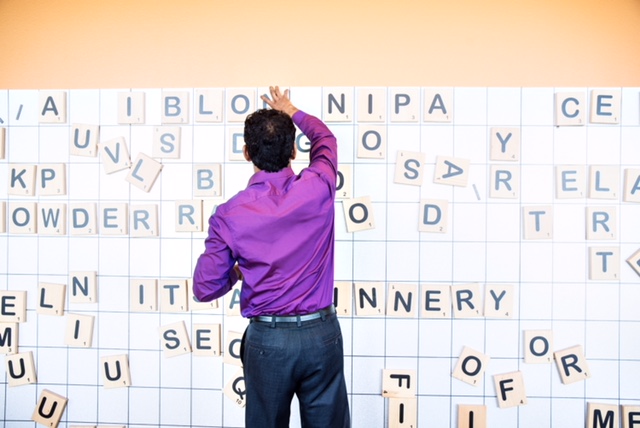NAB 2018’s Tasty Bowl of Acronym Soup: Serving “SMPTE 2110”


The 2018 NAB Show, along with a few lingering snowstorms, income taxes, and the alleged arrival of spring, are all theoretically behind us now -- but not without leaving a chunky trail of acronyms, at least in the case of NAB. Acronyms are a necessary evil in any industrial life, not because engineers are trying to drive us bananas with the grand geekery of it all, but because it’s just easier to say (as one of hundreds of examples) “SMPTE” (pronounced “simm-tea”) than it is to say “The Society of Motion Picture and Television Engineers.”
Like many of us in the video realm, we attempt to keep tabs on what is a steady flow of such impressively nerdy acronyms dotting the conversational landscape. Especially those that mark the transition of pretty much everything to IP, Internet Protocol. It started with the transition of SDI (Serial Digital Interface), essentially the starting line for the broadcast transition to IP.
There’s SMPTE 2022, in the works since 2007, as a “unidirectional, IP-based protocol for the transport of real-time video, audio and ancillary signals … in particular, a method for the encapsulation of the payloads of a variety of existing SMPTE serial digital video standards.”
The new one (to me, anyway) this year was SMPTE 2110, which builds on 2022 by unpacking each part of a signal (the video, the audio, and any ancillary data) into different IP streams, instead of being rolled together into one big transport stream. Each individual stream contains its own time stamp, which can be used at the receive end to line everything up so that it plays out correctly. (So, kind of like the IP version of lip sync.)
As someone much smarter than me took the time to explain in Las Vegas (thanks again, Subha!), SMPTE 2110 spans three pillars. The first: Off-the-shelf switching, as in video switching, so that broadcast and media providers can get away from buying big, all-in-one, monolithic switches. The reasoning: The inputs to any video switch tend to scale at different rates, dynamically. Therefore switches need to be able to also scale at different rates, dynamically.
Which brings up the second pillar: The ecosystem. One of the highlights at the Central Hall this year was the (always crowded) IP Showcase, where 56 suppliers representing the broadcast landscape came together, again, to demonstrate their collaborative work to interoperate -- not just as a “plug fest,” but more this year at an operational level. Background: That IP Showcase tends to move back and forth, across the Atlantic, from IBC to NAB and back again; that will be the case this September, in Amsterdam. It’s kind of assumed, by now, that one piece of gear can link to another, and they’ll both work as intended. This year, it was more about that next step -- how to make it work in real life, so that the people operating it can do so with relative ease. Meaning that their day-to-day, business-as-usual life stays reasonably the same, unfettered with the drudgery of relearning new ways to do the same things.
Last not least, SMPTE 2110 is further evidence of virtualization. Taking big, “bespoke” things, and unthreading them into their digital core. Maybe it’s an API (Application Program Interface) for a software-defined network (SDN) that gets teased out, standardized, open-sourced, and offered out to the community.
In theory and in practice (so far), SMPTE 2110 makes it easier for broadcast and media people to do more things, more quickly; to be more Internet-like. One example that came up over and over again was 4K video, already widely available on the display end (as evidenced in every consumer electronics store leading up to the Winter Olympics). Or prepping a venue to shift from, say, the Madonna concert on Saturday night, to the soccer match on Sunday afternoon. Or outfitting a control room for a multi-site production, without having to re-encode video multiple times.
So what does it take for the industry to be SMPTE 2110 ready? At the most basic level, it’s about those acronyms that are getting all broadcast applications and gear “souped-up” for IP. The next step is about how to work in that 2110 environment. What changes are necessary, in traditional broadcast operations, to accommodate the dynamic scaling of inputs and outputs?
The work of it is all shifting towards operating in IP. And scaling a network that previously would transport a few monolithic flows, but now has multiple IP-based flows -- all going to different end-points, but needing the precise timing to maintain broadcast accuracy and fidelity. If you visited the Cisco booth, for instance, it is that level of operations which were on display. You can find out more about that here. And you can be certain that in September, on the other side of the Atlantic, we’ll be talking more about operating in a 2110 environment.
Until then, be well and thrive!
About the Author: Leslie Ellis is a respected “technology translator,” known in cable and telecom circles for her award-winning, 20+ year “Translation Please” column in Multichannel News. She took on this Cisco-sponsored pre-NAB series to point out common and frustrating obstacles, for anyone on the sliding transition toward “being more Internet-like.” It is less of a comprehensive representation of available options and more a glimpse into what’s worrisome, on a day-to-day basis for engineers and IT people who work in media and entertainment.
Get the TV Tech Newsletter
The professional video industry's #1 source for news, trends and product and tech information. Sign up below.
